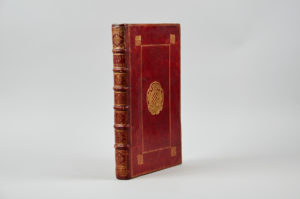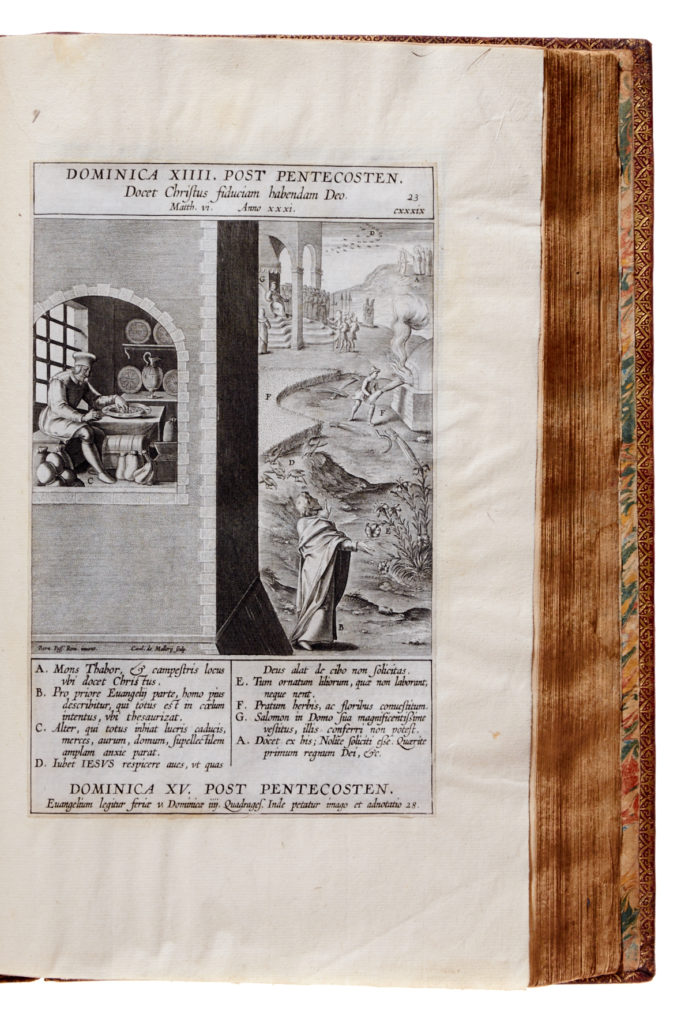Vorschau zur Auktion 74: Abteilung Inkunabeln, alte Drucke und Miniaturen
NATALIS (NADAL), H., Evangelicae historiae imagines. Antwerpen, (M. Nutius), 1593. Fol. Mit gestoch. Titel, ge stoch. Kopfvign., gestoch. Schlußvign. und 153 Kupfertafeln von A., H. und J. Wierix, K. von Mallery und J. Collaert nach M. de Vos und B. Passeri. 4 nn. Bl. Rotes Maroquin des 17. Jhdts. mit Rtit., Rvg. und Wappensupralibros auf beiden Deckeln sowie Steh- und Innenkantenvg.
10.000,- €
Erste Ausgabe. – STC 33 (als Tl. II der „Adnotationes et meditationes in evangelia“). Adams N 56. De Backer/ Sommervogel V , 1518. Funck 196 und 366. Palau 187148. Mauquoy-Hendrickx, Les Wierix illustrateurs de la Bible dite de Natalis, 26-64. – Erstdruck des separaten Tafelteiles, zu dem ein Jahr später die „Anmerkungen und Meditationen zu den Evangelien“ (Adnotationes et meditationes in evangelia) erschienen. – Obwohl das Werk erst 37 Jahre nach dem Tode des Ignatius von Loyola ver öffentlicht wurde, war es schon lange vor seiner Publikation inhaltlich konzipiert. Ignatius stand mit Nadal in persönlichem Kontakt und übte einen starken Einfluß auf die Gestaltung des Buches aus. Das Werk steht daher in ganz direktem Zusammenhang mit den Zielvorstellungen der frühen katholischen Reformbewegung und der Gegenreformation. Es begründet eine neue religiöse Kunstform, die die Eignung der Kunst zu religiöser Unterweisung nutzte. – Exemplar in dekorativem Wappeneinband, abgebildet bei Olivier 1468, 1, einem Mitglied der Familie Lotin de Charny zugeschrieben (nach Guigard II, 330).
First edition. – First print of the separate plate part, one year later the „Notes and meditations to the gospels“ (Adnotationes et meditationes in evangelia) were published. – Although the work was published only 37 years after the death of Ignatius of Loyola, the content had been structured long before its publication. Ignatius stayed in personal contact with Nadal and had a strong influence on the structuring of the book. The work therefore is closely associated with the objectives of the early Catholic reform movement and Counter-Reformation. It justifies a new religious art form that used the suitability of the art for religious instruction. – The copy in a decorative heraldic binding, depicted by Olivier 1468, 1, attributed to a member of the family Lotin de Charny (after Guigard II, 330). – Red morocco of the 17th century with spine title, gilt back and armorial supralibros on both covers as well as gilt outside and interior edges (joints and corners professionally restored, a little rubbed and scuffed).
>> zum nächsten Objekt


